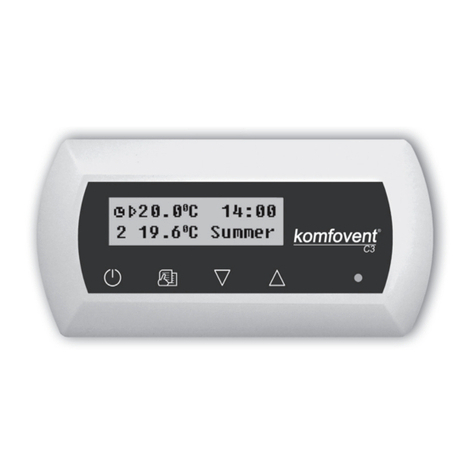
UAB KOMFOVENT we reserve the right to make changes without prior notice
C5.1_22- 08 3
Thissymbolindicatesthatthisproductisnottobedisposedofwithyourhouseholdwaste,accordingtothe
WEEEDirective(2002/96/EC)andyournationallaw.Thisproductshouldbehandedovertoadesignated
collection point, or to an authorised collection site for recycling waste electrical and electronic equi-
pment (EEE). Improper handling of this type of waste could have a possible negative impact on the
environment and human health due to potentially hazardous substances that are generally associ-
ated with EEE. At the same time, your cooperation in the correct disposal of this product will contri-
bute to the eective usage of natural resources. For more information about where you can drop o
your waste equipment for recycling, please contact your local city oce, waste authority, approved
WEEE scheme or your household waste disposal service.
Content
1. ELECTRICAL INSTALLATION MANUAL......................................................................................................................4
1.1. Air Handling Units Sections Connection.................................................................................................................4
1.2. Electric Power Supply Connection ...........................................................................................................................4
1.3. External Elements Connection...................................................................................................................................5
1.4. Temperature Sensors Installation..............................................................................................................................6
1.5. Requirements for the installation of the control panel ....................................................................................6
1.6. Control panel connection ............................................................................................................................................6
2. OPERATION MANUAL ........................................................................................................................................................7
2.1. Unit Control........................................................................................................................................................................7
2.2. Control panel indication...............................................................................................................................................7
2.3. Parameters overview .....................................................................................................................................................8
2.4. Operation modes selection.........................................................................................................................................8
2.5. Menu ....................................................................................................................................................................................9
2.5.1. Overview.................................................................................................................................................................9
2.5.1.1. Alarms........................................................................................................................................................9
2.5.1.2. Operation counters .............................................................................................................................9
2.5.1.3. Eciency status....................................................................................................................................9
2.5.1.4. Detailed information ..........................................................................................................................9
2.5.2. Functions..............................................................................................................................................................10
2.5.2.1. Air quality control ..............................................................................................................................10
2.5.2.2. Operation on demand ....................................................................................................................10
2.5.2.3. Outdoor compensated ventilation ............................................................................................11
2.5.2.4. Summer night cooling ....................................................................................................................11
2.5.2.5. Minimum temperature control ...................................................................................................11
2.5.2.6. Override function .............................................................................................................................12
2.5.2.7. Humidity control ...............................................................................................................................12
2.5.3. Scheduling...........................................................................................................................................................13
2.5.3.1. Operation program...........................................................................................................................13
2.5.4. Settings .................................................................................................................................................................13
2.5.3.2. Holidays.................................................................................................................................................13
2.5.4.1. Air handling unit settings ..............................................................................................................14
2.5.4.2. Personalization...................................................................................................................................16
2.6. Control of air handling units through a web browser.....................................................................................16
2.7. Additional control options.........................................................................................................................................17
2.7.1. Combined water coil control .........................................................................................................................17
2.7.2. Inverter direct evaporation cooler control ..............................................................................................17
2.7.3. Multi-level control of direct evaporation cooler ...................................................................................17
2.7.4. Reversal of direct evaporation coolers......................................................................................................17
2.8. Troubleshooting ............................................................................................................................................................18




























